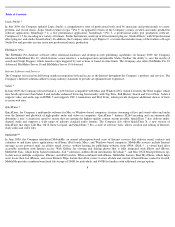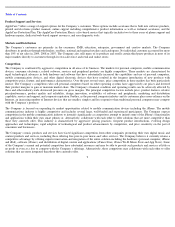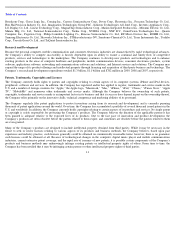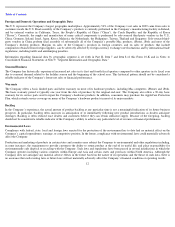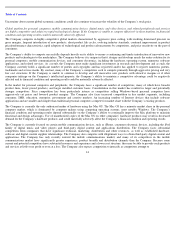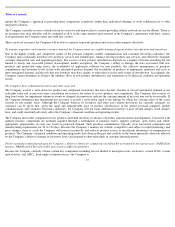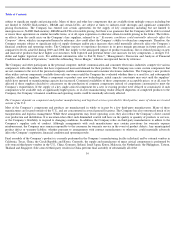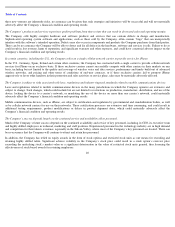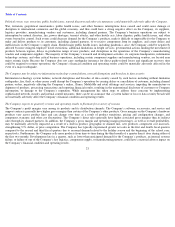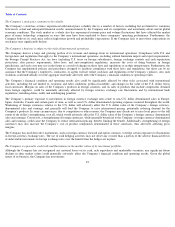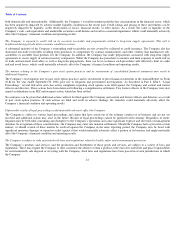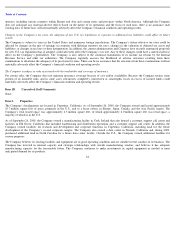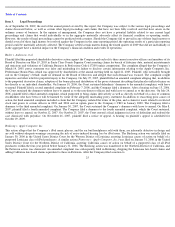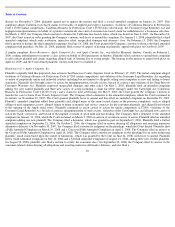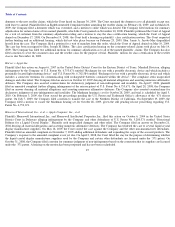Apple 2009 Annual Report Download - page 21
Download and view the complete annual report
Please find page 21 of the 2009 Apple annual report below. You can navigate through the pages in the report by either clicking on the pages listed below, or by using the keyword search tool below to find specific information within the annual report.
Table of Contents
the Company fail to prevail in any of the matters related to infringement of patent or other intellectual property rights of others or should several
of these matters be resolved against the Company in the same reporting period, the Company’
s financial condition and operating results could be
materially adversely affected.
With the June 2007 introduction of iPhone, the Company has begun to compete with mobile communication device companies that hold
significant patent portfolios. Regardless of the scope or validity of such patents or the merits of any potential patent claims by competitors, the
Company may have to engage in protracted litigation, enter into expensive agreements or settlements and/or modify its products. Any of these
events could have a material adverse impact on the Company’s financial condition and operating results.
The Company’s future performance depends on support from third-party software developers. If third-
party software applications and services
cease to be developed and maintained for the Company’s products, customers may choose not to buy the Company’s products.
The Company believes decisions by customers to purchase its hardware products, including its Macs, iPhones and iPods, are often based to a
certain extent on the availability of third-party software applications and services. There is no assurance that third-
party developers will continue
to develop and maintain applications and services for the Company’
s products on a timely basis or at all, and discontinuance or delay of these
applications and services could materially adversely affect the Company’s financial condition and operating results.
With respect to its Mac products, the Company believes the availability of third-
party software applications and services depends in part on the
developers’ perception and analysis of the relative benefits of developing, maintaining, and upgrading such software for the Company’
s products
compared to Windows-
based products. This analysis may be based on factors such as the perceived strength of the Company and its products,
the anticipated revenue that may be generated, continued acceptance by customers of Mac OS X, and the costs of developing such applications
and services. If the Company’s minority share of the global personal computer market causes developers to question the Company’
s prospects,
developers could be less inclined to develop or upgrade software for the Company’
s products and more inclined to devote their resources to
developing and upgrading software for the larger Windows market. The Company’
s development of its own software applications and services
may also negatively affect the decisions of third-
party developers, such as Microsoft, Adobe and Google, to develop, maintain, and upgrade
similar or competitive software and services for the Company’s products. Mac OS X Version 10.5 Leopard (“Mac OS X Leopard”),
which
became available in October 2007, includes a new feature that enables Intel-
based Mac systems to run Microsoft Windows XP and Windows
Vista operating systems. This feature may deter developers from creating software applications for Mac OS X if such applications are already
available for the Windows platform.
With respect to iPhone and iPod touch, the Company relies on the continued availability and development of compelling and innovative software
applications. Unlike third-
party software applications for Mac products, the software applications for the iPhone and iPod touch platforms are
distributed through a single distribution channel, the App Store. The absence of multiple distribution channels, which are available for competing
platforms, may limit the availability and acceptance of third-party applications by the Company’
s customers, thereby causing developers to
curtail significantly, or stop, development for the Company’
s platforms. In addition, iPhone and iPod touch are subject to rapid technological
change, and, if third-party developers are unable to keep up with this pace of change, third-
party applications might not successfully operate and
may result in dissatisfied customers. Further, if the Company develops its own software applications and services, such development may
negatively affect the decisions of third-
party developers to develop, maintain, and upgrade similar or competitive applications for the iPhone and
iPod touch platforms. As with applications for the Company’
s Mac products, the availability and development of these applications also depend
on developers’ perceptions and analysis of the relative benefits of developing software for the Company’s products rather than its competitors’
products, including devices that use competing platforms. If developers focus their efforts on these competing platforms, the availability and
quality of applications for the Company’s devices may suffer.
18


